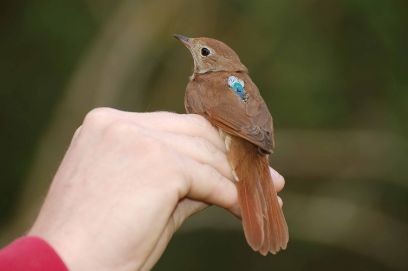- Research Project
Researching migration routes and activities of small birds
BFH has developed geolocators for the Swiss Ornithological Institute in Sempach. These are being used in studies to record the migration routes and activities of different bird species. The researchers regularly make improvements to the geolocators.
Factsheet
- Institute(s) Institute for Intelligent Industrial Systems (I3S)
- Research unit(s) I3S / Embedded Systems
- Duration (planned) 01.02.2008 - 01.01.2022
- Head of project Roger Weber
-
Project staff
Simon von Ballmoos - formerly BFH
Dominik von Rohr - formerly BFH
Tim Wacher - formerly BFH
Joël Bärtschi - formerly BFH
Matthias Schranz - formerly BFH
Stefan Lüthi -
Partner
Swiss Ornithological Institute
FOEN - Keywords Geolocator, Swiss Ornithological Institute, Birds
Starting point
The dangers experienced by migratory birds extend beyond their breeding grounds. To ensure measures to protect migratory bird species are successful, we need to know their migration routes as well as their resting, wintering and breeding grounds. Geolocators provide the data required for this.
Goals
This project seeks to develop various geolocators weighing 0.5g and more that can record the position and activity of songbirds.
Procedure
The hardware and software are developed by BFH, and the geolocators are then tested in collaboration with the Swiss Ornithological Institute. The prints are produced by an industrial partner in Switzerland, while the Ornithological Institute takes care of final assembly. The Ornithological Institute also carries out the field studies, sometimes working in collaboration with other institutions. The results of the studies are published regularly in papers.
Solution
The Ornithological Institute currently uses the following three types of geolocator in particular:
- GDL2: Weighing just 0.5g (including battery and mounting system), this is the lightest model used. The GDL2 records changes in sunlight levels over one year. This data can be used to determine where the birds are each day, and therefore also their migratory routes and wintering grounds.
- GDL3pam: This geolocator weighs around 1g and is equipped with additional sensors for measuring the birds’ activity. It can measure and record the air pressure, acceleration and the earth’s magnetic field. The GDL3pam was used to prove that Alpine swifts can remain airborne for 200 days during winter and autumn.
- µTag: The newest model of geolocator has an integrated transceiver that can be used to determine the birds’ location and download the data automatically. A small photovoltaic module can be added to power the logger, allowing it to operate for several years at a time.
